Nursing Professional: Case Study
VerifiedAdded on 2023/01/05
|10
|2018
|24
AI Summary
This case study explores the planning of person-centered care and effective communication in the nursing profession. It discusses the assessment of pain using the Numeric Rating Scale and PQRST assessment tool, as well as nursing interventions to reduce pain and improve communication with the patient. The case study also includes a background of the patient, assessment findings, and recommendations for care.
Contribute Materials
Your contribution can guide someone’s learning journey. Share your
documents today.
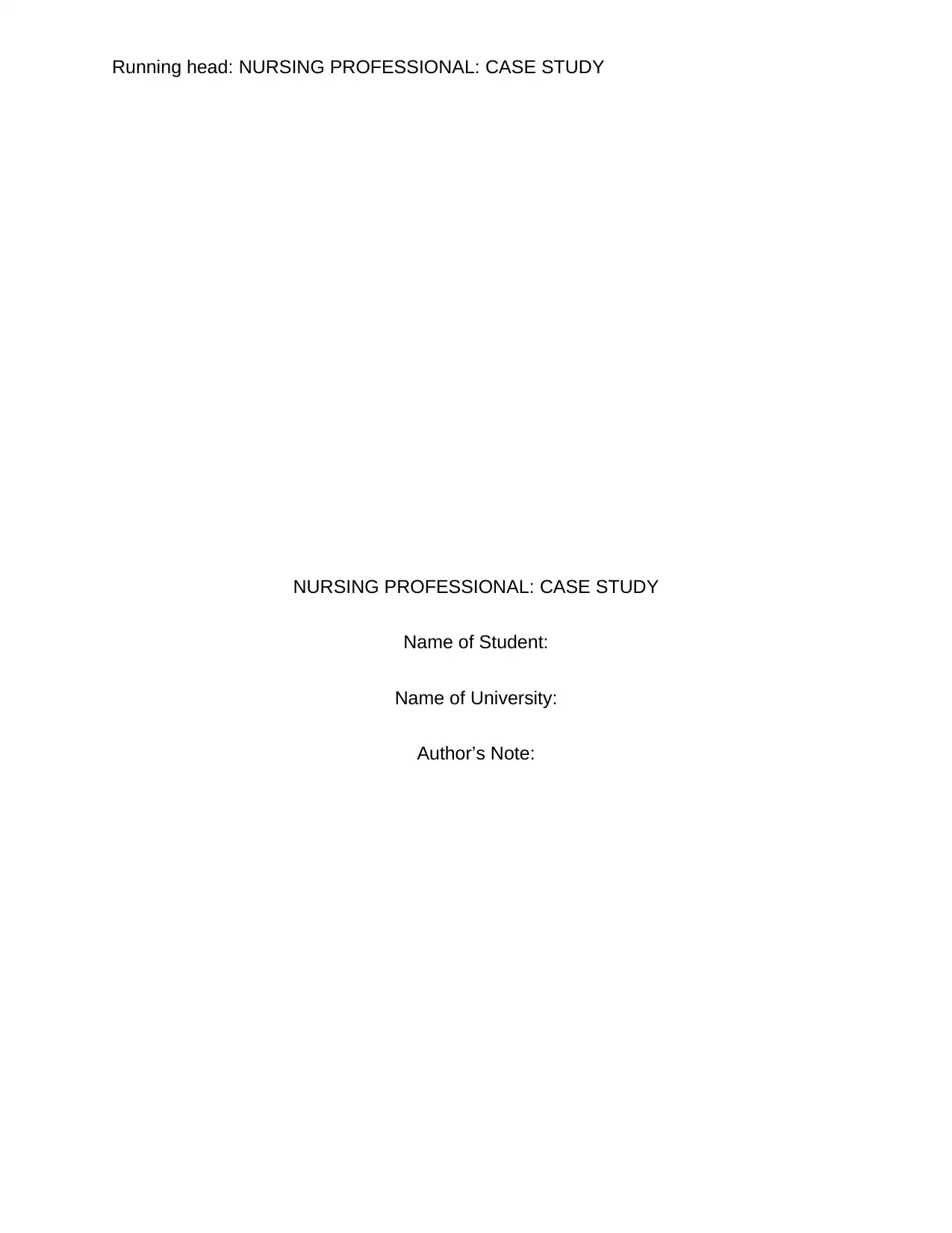
Running head: NURSING PROFESSIONAL: CASE STUDY
NURSING PROFESSIONAL: CASE STUDY
Name of Student:
Name of University:
Author’s Note:
NURSING PROFESSIONAL: CASE STUDY
Name of Student:
Name of University:
Author’s Note:
Secure Best Marks with AI Grader
Need help grading? Try our AI Grader for instant feedback on your assignments.
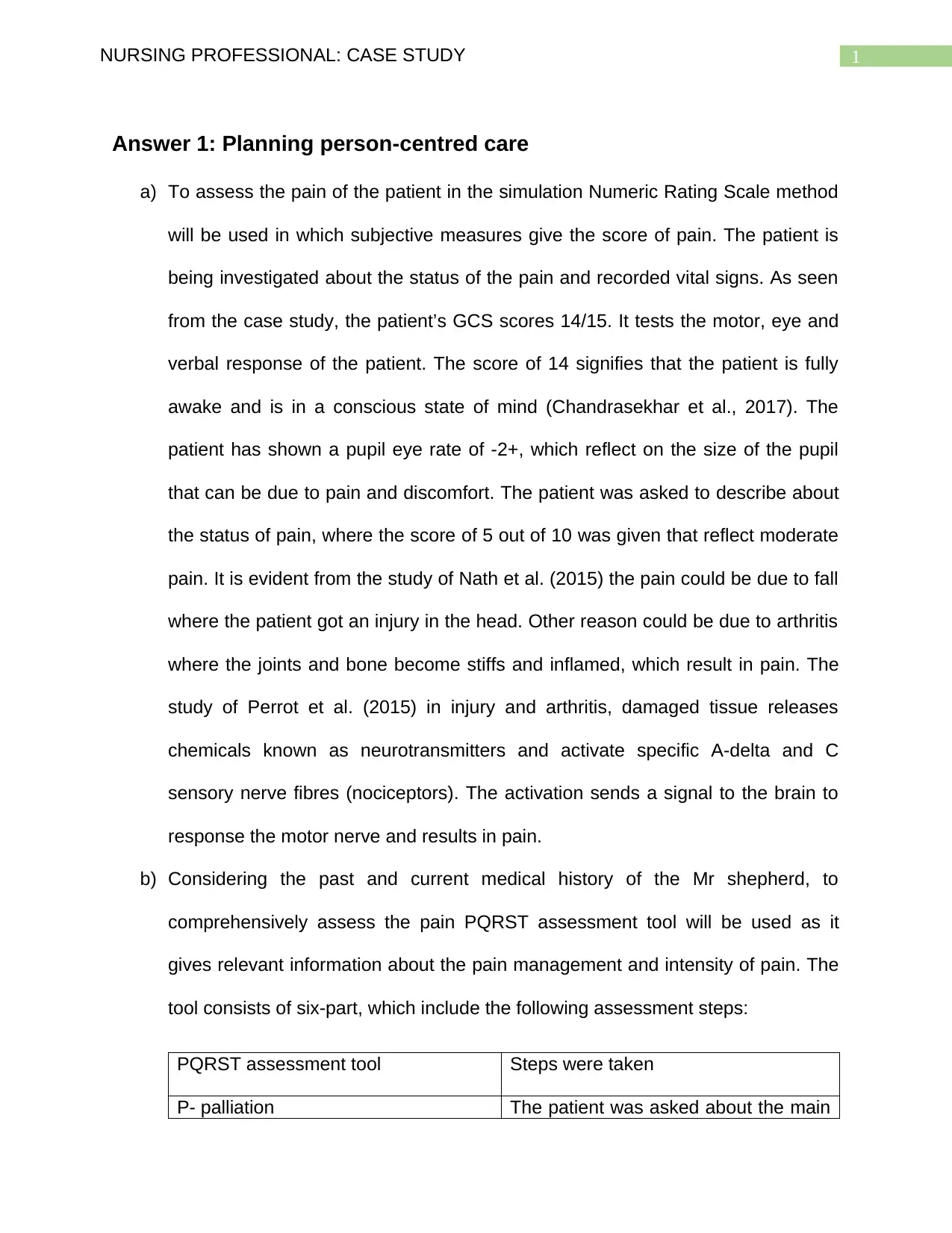
1NURSING PROFESSIONAL: CASE STUDY
Answer 1: Planning person-centred care
a) To assess the pain of the patient in the simulation Numeric Rating Scale method
will be used in which subjective measures give the score of pain. The patient is
being investigated about the status of the pain and recorded vital signs. As seen
from the case study, the patient’s GCS scores 14/15. It tests the motor, eye and
verbal response of the patient. The score of 14 signifies that the patient is fully
awake and is in a conscious state of mind (Chandrasekhar et al., 2017). The
patient has shown a pupil eye rate of -2+, which reflect on the size of the pupil
that can be due to pain and discomfort. The patient was asked to describe about
the status of pain, where the score of 5 out of 10 was given that reflect moderate
pain. It is evident from the study of Nath et al. (2015) the pain could be due to fall
where the patient got an injury in the head. Other reason could be due to arthritis
where the joints and bone become stiffs and inflamed, which result in pain. The
study of Perrot et al. (2015) in injury and arthritis, damaged tissue releases
chemicals known as neurotransmitters and activate specific A-delta and C
sensory nerve fibres (nociceptors). The activation sends a signal to the brain to
response the motor nerve and results in pain.
b) Considering the past and current medical history of the Mr shepherd, to
comprehensively assess the pain PQRST assessment tool will be used as it
gives relevant information about the pain management and intensity of pain. The
tool consists of six-part, which include the following assessment steps:
PQRST assessment tool Steps were taken
P- palliation The patient was asked about the main
Answer 1: Planning person-centred care
a) To assess the pain of the patient in the simulation Numeric Rating Scale method
will be used in which subjective measures give the score of pain. The patient is
being investigated about the status of the pain and recorded vital signs. As seen
from the case study, the patient’s GCS scores 14/15. It tests the motor, eye and
verbal response of the patient. The score of 14 signifies that the patient is fully
awake and is in a conscious state of mind (Chandrasekhar et al., 2017). The
patient has shown a pupil eye rate of -2+, which reflect on the size of the pupil
that can be due to pain and discomfort. The patient was asked to describe about
the status of pain, where the score of 5 out of 10 was given that reflect moderate
pain. It is evident from the study of Nath et al. (2015) the pain could be due to fall
where the patient got an injury in the head. Other reason could be due to arthritis
where the joints and bone become stiffs and inflamed, which result in pain. The
study of Perrot et al. (2015) in injury and arthritis, damaged tissue releases
chemicals known as neurotransmitters and activate specific A-delta and C
sensory nerve fibres (nociceptors). The activation sends a signal to the brain to
response the motor nerve and results in pain.
b) Considering the past and current medical history of the Mr shepherd, to
comprehensively assess the pain PQRST assessment tool will be used as it
gives relevant information about the pain management and intensity of pain. The
tool consists of six-part, which include the following assessment steps:
PQRST assessment tool Steps were taken
P- palliation The patient was asked about the main
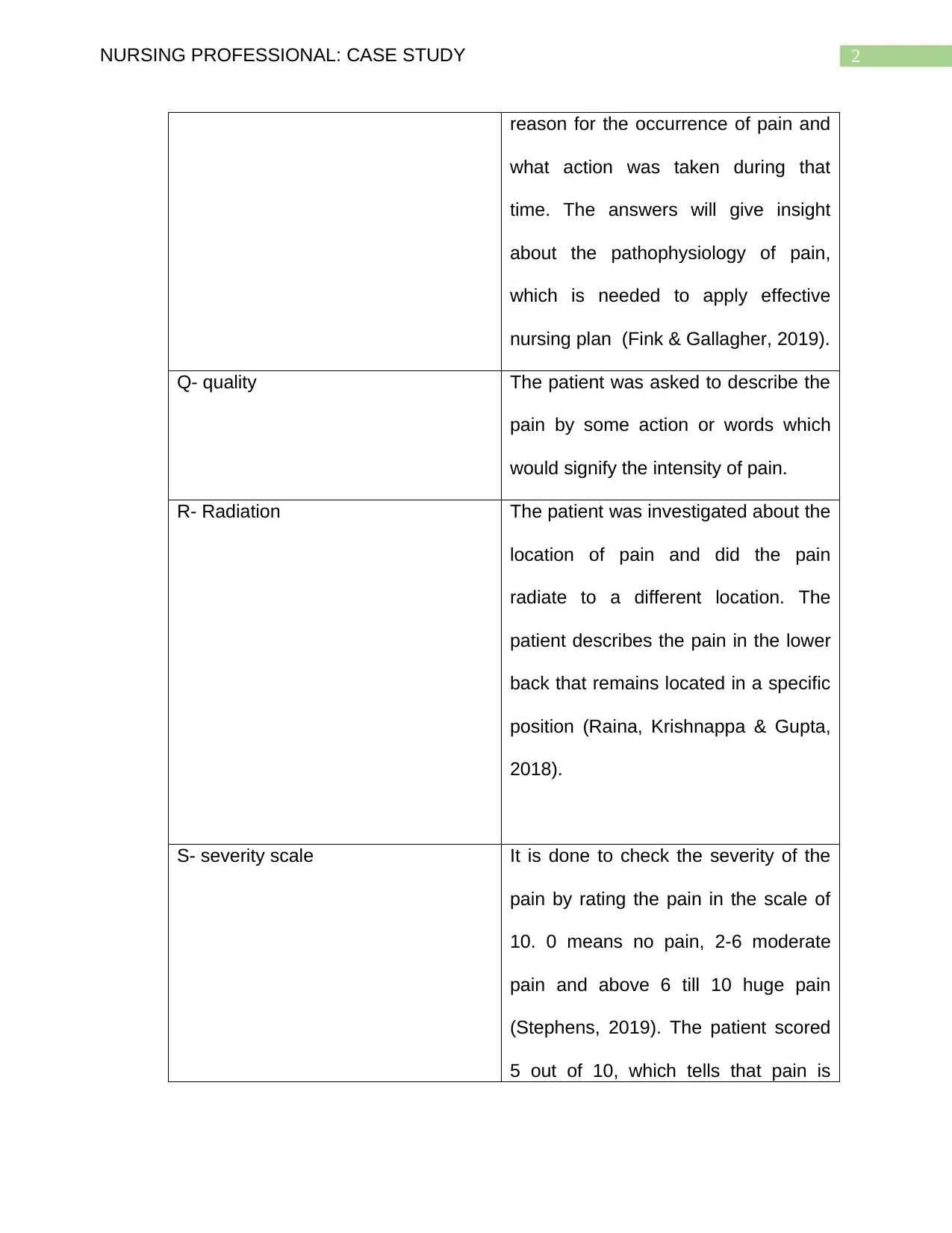
2NURSING PROFESSIONAL: CASE STUDY
reason for the occurrence of pain and
what action was taken during that
time. The answers will give insight
about the pathophysiology of pain,
which is needed to apply effective
nursing plan (Fink & Gallagher, 2019).
Q- quality The patient was asked to describe the
pain by some action or words which
would signify the intensity of pain.
R- Radiation The patient was investigated about the
location of pain and did the pain
radiate to a different location. The
patient describes the pain in the lower
back that remains located in a specific
position (Raina, Krishnappa & Gupta,
2018).
S- severity scale It is done to check the severity of the
pain by rating the pain in the scale of
10. 0 means no pain, 2-6 moderate
pain and above 6 till 10 huge pain
(Stephens, 2019). The patient scored
5 out of 10, which tells that pain is
reason for the occurrence of pain and
what action was taken during that
time. The answers will give insight
about the pathophysiology of pain,
which is needed to apply effective
nursing plan (Fink & Gallagher, 2019).
Q- quality The patient was asked to describe the
pain by some action or words which
would signify the intensity of pain.
R- Radiation The patient was investigated about the
location of pain and did the pain
radiate to a different location. The
patient describes the pain in the lower
back that remains located in a specific
position (Raina, Krishnappa & Gupta,
2018).
S- severity scale It is done to check the severity of the
pain by rating the pain in the scale of
10. 0 means no pain, 2-6 moderate
pain and above 6 till 10 huge pain
(Stephens, 2019). The patient scored
5 out of 10, which tells that pain is
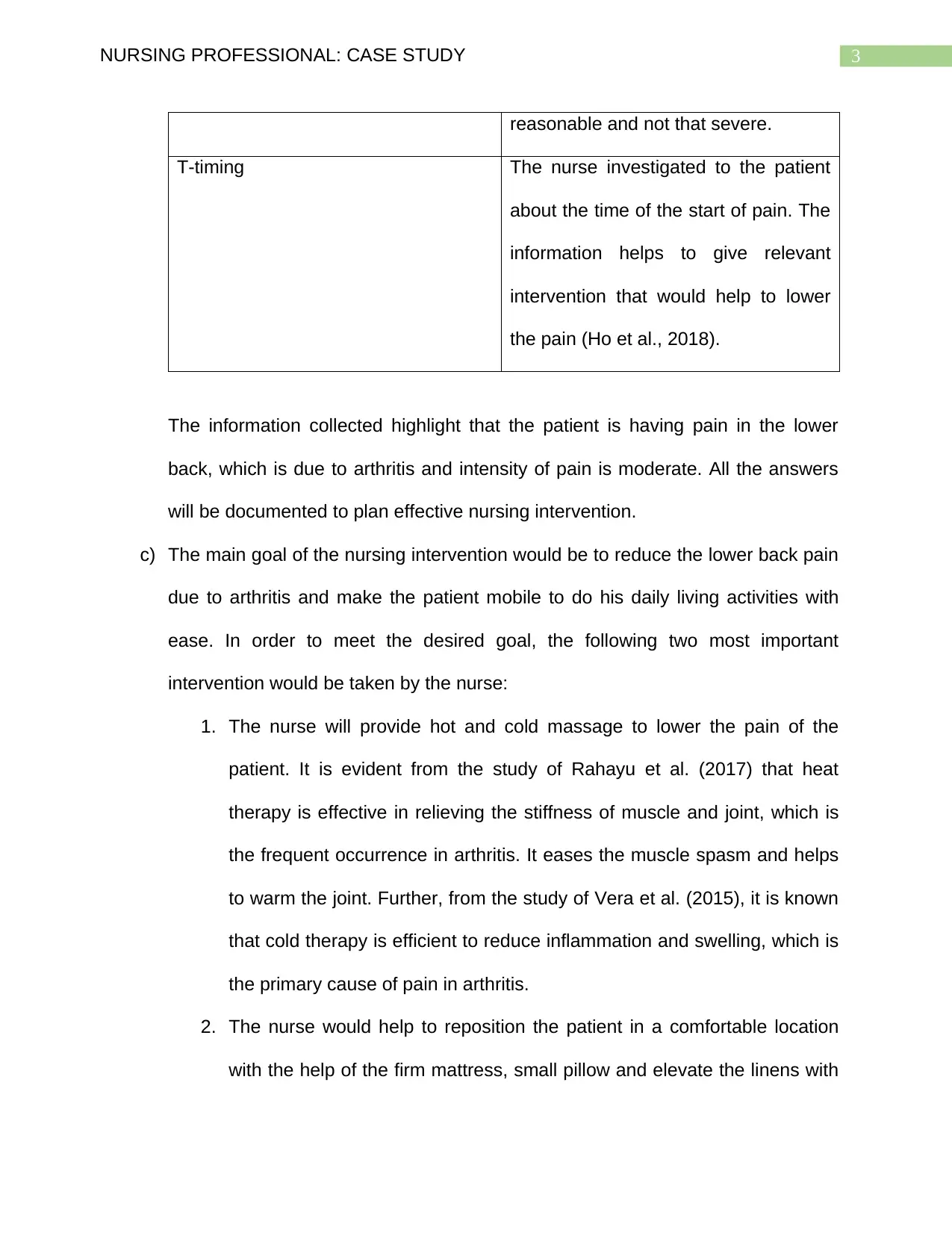
3NURSING PROFESSIONAL: CASE STUDY
reasonable and not that severe.
T-timing The nurse investigated to the patient
about the time of the start of pain. The
information helps to give relevant
intervention that would help to lower
the pain (Ho et al., 2018).
The information collected highlight that the patient is having pain in the lower
back, which is due to arthritis and intensity of pain is moderate. All the answers
will be documented to plan effective nursing intervention.
c) The main goal of the nursing intervention would be to reduce the lower back pain
due to arthritis and make the patient mobile to do his daily living activities with
ease. In order to meet the desired goal, the following two most important
intervention would be taken by the nurse:
1. The nurse will provide hot and cold massage to lower the pain of the
patient. It is evident from the study of Rahayu et al. (2017) that heat
therapy is effective in relieving the stiffness of muscle and joint, which is
the frequent occurrence in arthritis. It eases the muscle spasm and helps
to warm the joint. Further, from the study of Vera et al. (2015), it is known
that cold therapy is efficient to reduce inflammation and swelling, which is
the primary cause of pain in arthritis.
2. The nurse would help to reposition the patient in a comfortable location
with the help of the firm mattress, small pillow and elevate the linens with
reasonable and not that severe.
T-timing The nurse investigated to the patient
about the time of the start of pain. The
information helps to give relevant
intervention that would help to lower
the pain (Ho et al., 2018).
The information collected highlight that the patient is having pain in the lower
back, which is due to arthritis and intensity of pain is moderate. All the answers
will be documented to plan effective nursing intervention.
c) The main goal of the nursing intervention would be to reduce the lower back pain
due to arthritis and make the patient mobile to do his daily living activities with
ease. In order to meet the desired goal, the following two most important
intervention would be taken by the nurse:
1. The nurse will provide hot and cold massage to lower the pain of the
patient. It is evident from the study of Rahayu et al. (2017) that heat
therapy is effective in relieving the stiffness of muscle and joint, which is
the frequent occurrence in arthritis. It eases the muscle spasm and helps
to warm the joint. Further, from the study of Vera et al. (2015), it is known
that cold therapy is efficient to reduce inflammation and swelling, which is
the primary cause of pain in arthritis.
2. The nurse would help to reposition the patient in a comfortable location
with the help of the firm mattress, small pillow and elevate the linens with
Secure Best Marks with AI Grader
Need help grading? Try our AI Grader for instant feedback on your assignments.
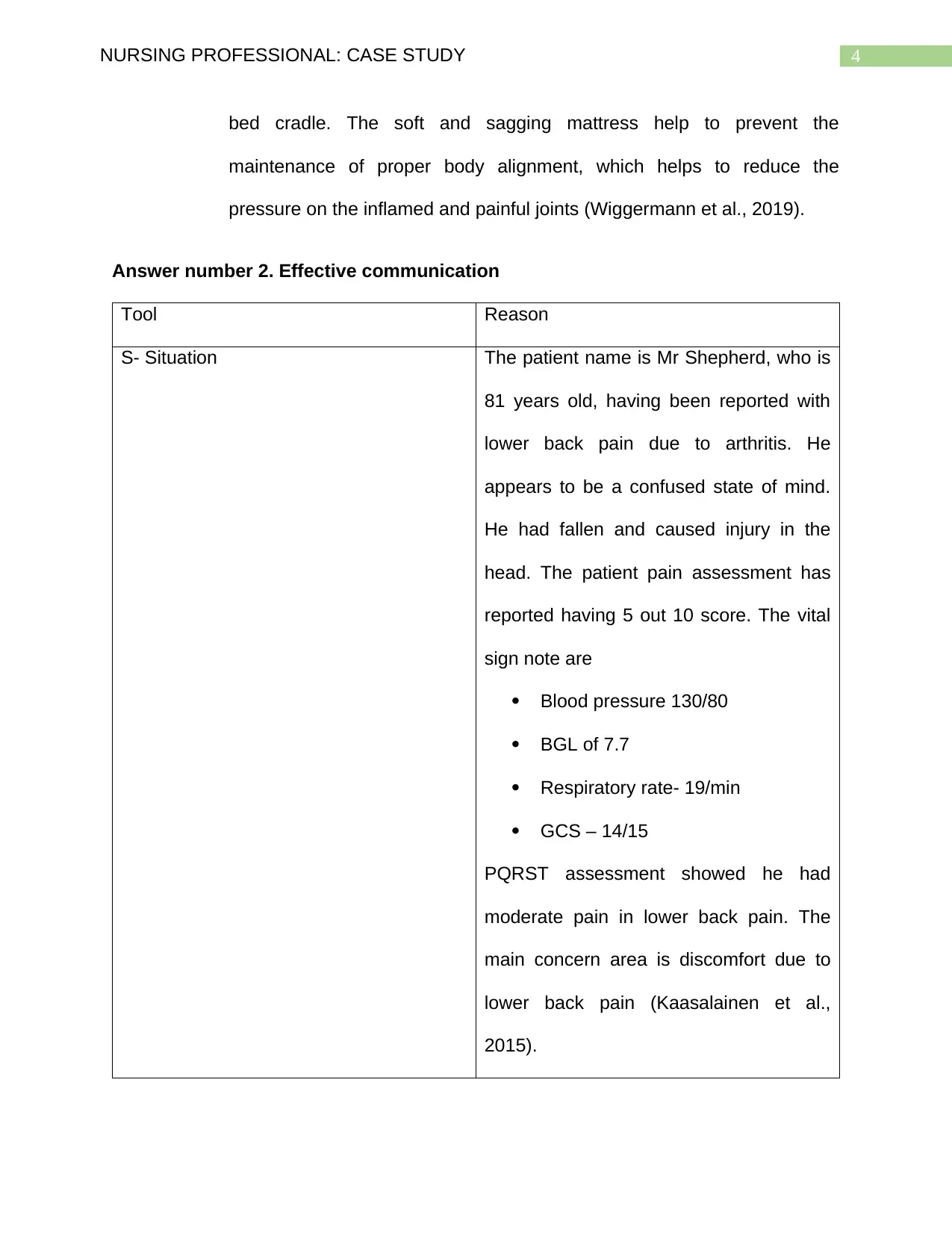
4NURSING PROFESSIONAL: CASE STUDY
bed cradle. The soft and sagging mattress help to prevent the
maintenance of proper body alignment, which helps to reduce the
pressure on the inflamed and painful joints (Wiggermann et al., 2019).
Answer number 2. Effective communication
Tool Reason
S- Situation The patient name is Mr Shepherd, who is
81 years old, having been reported with
lower back pain due to arthritis. He
appears to be a confused state of mind.
He had fallen and caused injury in the
head. The patient pain assessment has
reported having 5 out 10 score. The vital
sign note are
Blood pressure 130/80
BGL of 7.7
Respiratory rate- 19/min
GCS – 14/15
PQRST assessment showed he had
moderate pain in lower back pain. The
main concern area is discomfort due to
lower back pain (Kaasalainen et al.,
2015).
bed cradle. The soft and sagging mattress help to prevent the
maintenance of proper body alignment, which helps to reduce the
pressure on the inflamed and painful joints (Wiggermann et al., 2019).
Answer number 2. Effective communication
Tool Reason
S- Situation The patient name is Mr Shepherd, who is
81 years old, having been reported with
lower back pain due to arthritis. He
appears to be a confused state of mind.
He had fallen and caused injury in the
head. The patient pain assessment has
reported having 5 out 10 score. The vital
sign note are
Blood pressure 130/80
BGL of 7.7
Respiratory rate- 19/min
GCS – 14/15
PQRST assessment showed he had
moderate pain in lower back pain. The
main concern area is discomfort due to
lower back pain (Kaasalainen et al.,
2015).
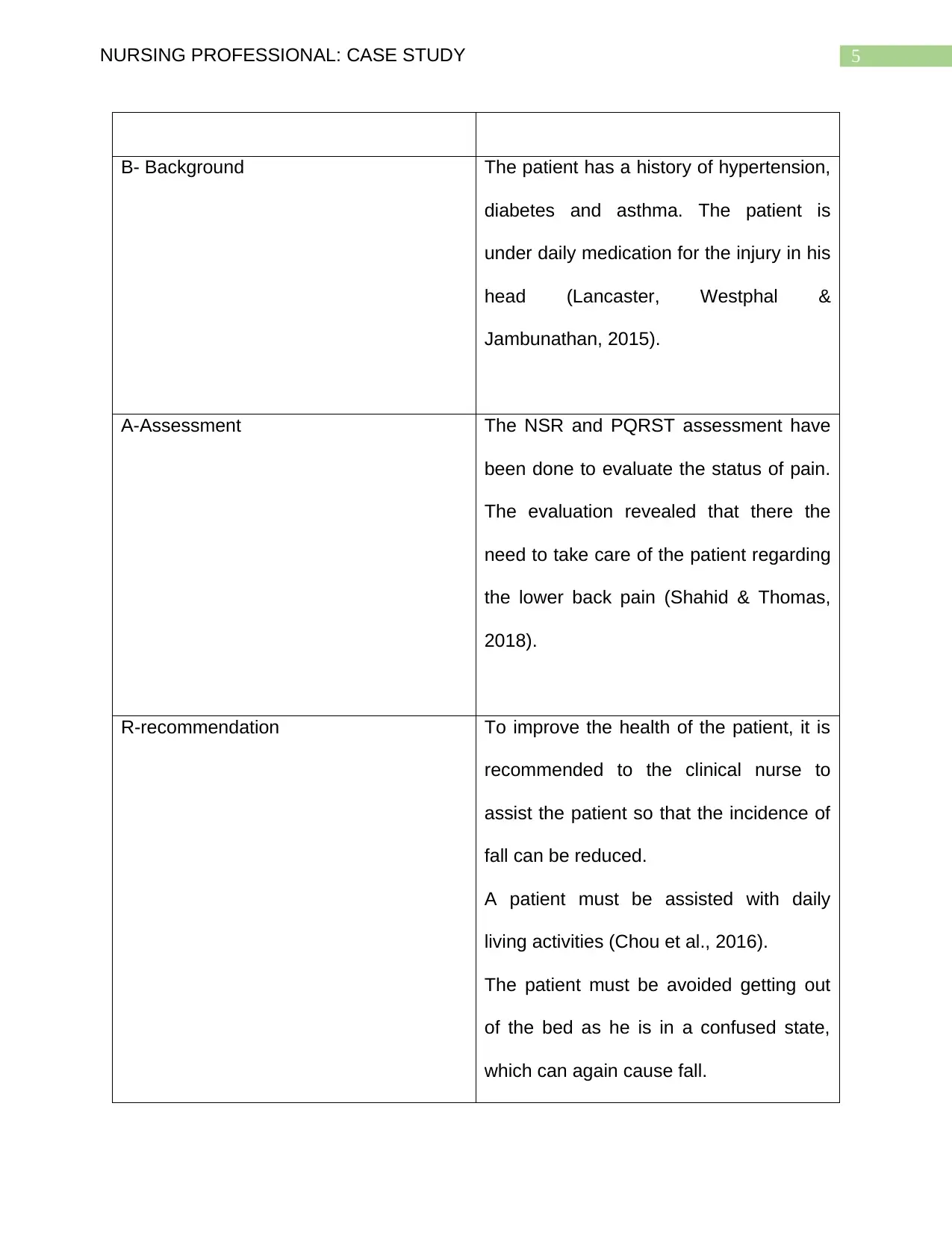
5NURSING PROFESSIONAL: CASE STUDY
B- Background The patient has a history of hypertension,
diabetes and asthma. The patient is
under daily medication for the injury in his
head (Lancaster, Westphal &
Jambunathan, 2015).
A-Assessment The NSR and PQRST assessment have
been done to evaluate the status of pain.
The evaluation revealed that there the
need to take care of the patient regarding
the lower back pain (Shahid & Thomas,
2018).
R-recommendation To improve the health of the patient, it is
recommended to the clinical nurse to
assist the patient so that the incidence of
fall can be reduced.
A patient must be assisted with daily
living activities (Chou et al., 2016).
The patient must be avoided getting out
of the bed as he is in a confused state,
which can again cause fall.
B- Background The patient has a history of hypertension,
diabetes and asthma. The patient is
under daily medication for the injury in his
head (Lancaster, Westphal &
Jambunathan, 2015).
A-Assessment The NSR and PQRST assessment have
been done to evaluate the status of pain.
The evaluation revealed that there the
need to take care of the patient regarding
the lower back pain (Shahid & Thomas,
2018).
R-recommendation To improve the health of the patient, it is
recommended to the clinical nurse to
assist the patient so that the incidence of
fall can be reduced.
A patient must be assisted with daily
living activities (Chou et al., 2016).
The patient must be avoided getting out
of the bed as he is in a confused state,
which can again cause fall.
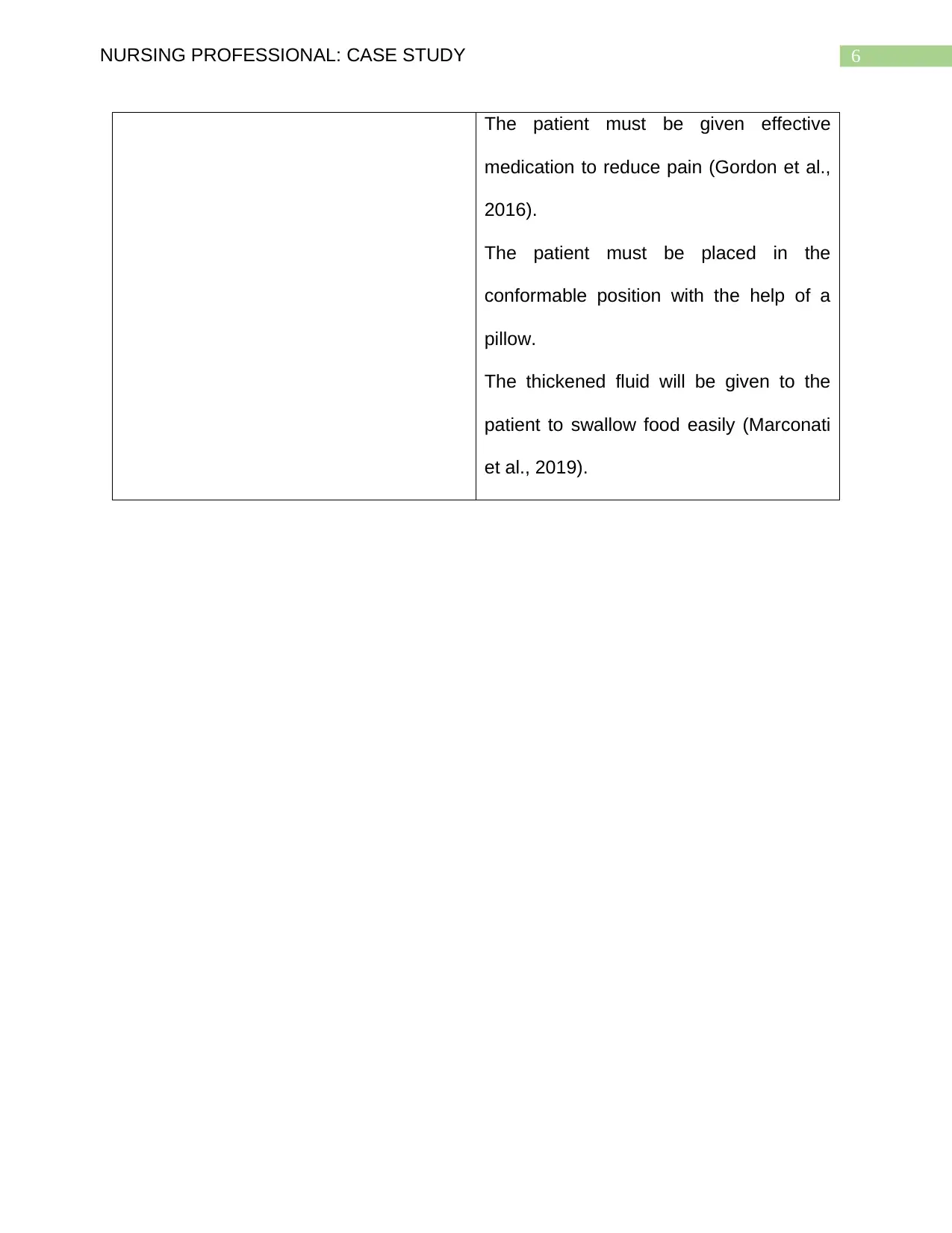
6NURSING PROFESSIONAL: CASE STUDY
The patient must be given effective
medication to reduce pain (Gordon et al.,
2016).
The patient must be placed in the
conformable position with the help of a
pillow.
The thickened fluid will be given to the
patient to swallow food easily (Marconati
et al., 2019).
The patient must be given effective
medication to reduce pain (Gordon et al.,
2016).
The patient must be placed in the
conformable position with the help of a
pillow.
The thickened fluid will be given to the
patient to swallow food easily (Marconati
et al., 2019).
Paraphrase This Document
Need a fresh take? Get an instant paraphrase of this document with our AI Paraphraser
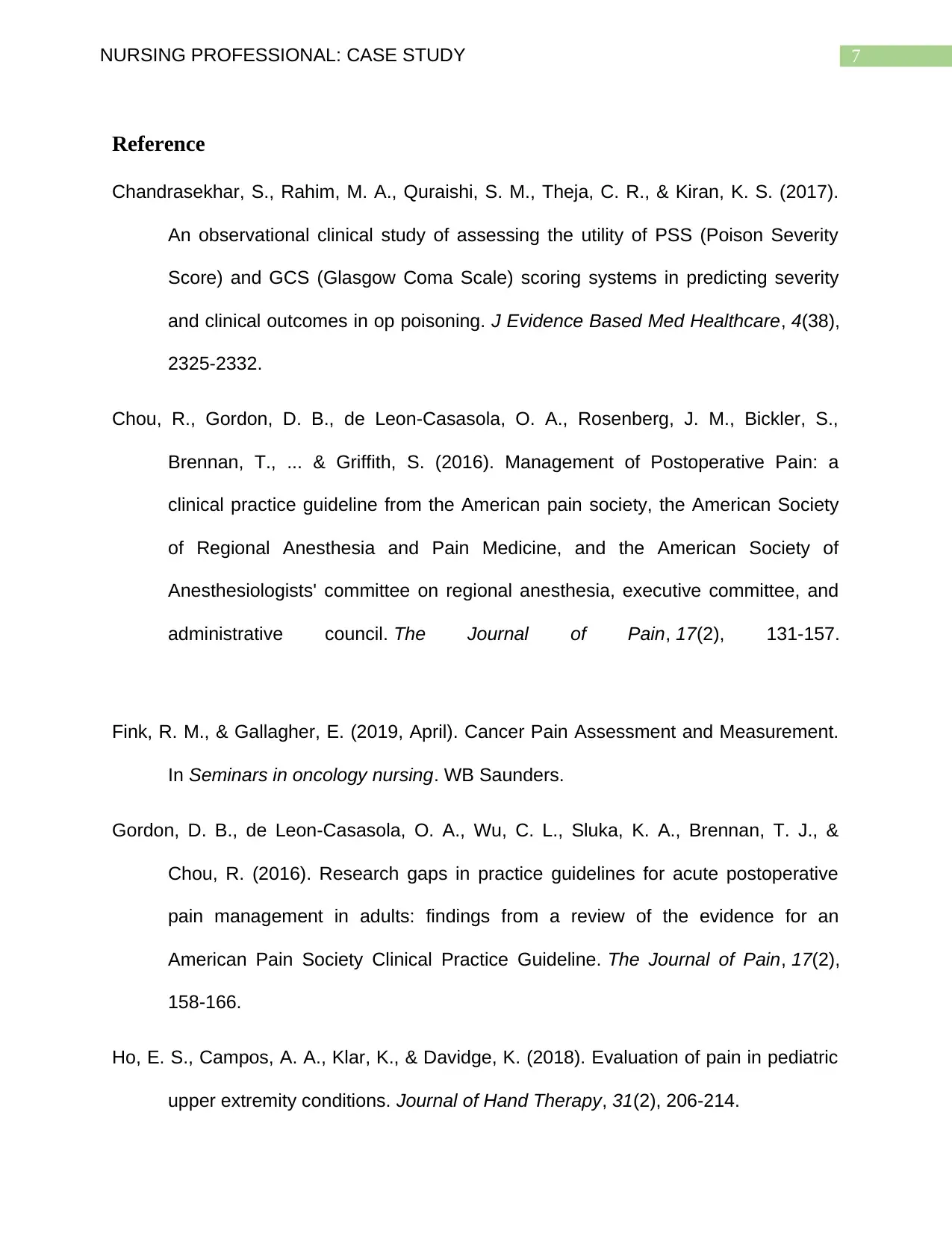
7NURSING PROFESSIONAL: CASE STUDY
Reference
Chandrasekhar, S., Rahim, M. A., Quraishi, S. M., Theja, C. R., & Kiran, K. S. (2017).
An observational clinical study of assessing the utility of PSS (Poison Severity
Score) and GCS (Glasgow Coma Scale) scoring systems in predicting severity
and clinical outcomes in op poisoning. J Evidence Based Med Healthcare, 4(38),
2325-2332.
Chou, R., Gordon, D. B., de Leon-Casasola, O. A., Rosenberg, J. M., Bickler, S.,
Brennan, T., ... & Griffith, S. (2016). Management of Postoperative Pain: a
clinical practice guideline from the American pain society, the American Society
of Regional Anesthesia and Pain Medicine, and the American Society of
Anesthesiologists' committee on regional anesthesia, executive committee, and
administrative council. The Journal of Pain, 17(2), 131-157.
Fink, R. M., & Gallagher, E. (2019, April). Cancer Pain Assessment and Measurement.
In Seminars in oncology nursing. WB Saunders.
Gordon, D. B., de Leon-Casasola, O. A., Wu, C. L., Sluka, K. A., Brennan, T. J., &
Chou, R. (2016). Research gaps in practice guidelines for acute postoperative
pain management in adults: findings from a review of the evidence for an
American Pain Society Clinical Practice Guideline. The Journal of Pain, 17(2),
158-166.
Ho, E. S., Campos, A. A., Klar, K., & Davidge, K. (2018). Evaluation of pain in pediatric
upper extremity conditions. Journal of Hand Therapy, 31(2), 206-214.
Reference
Chandrasekhar, S., Rahim, M. A., Quraishi, S. M., Theja, C. R., & Kiran, K. S. (2017).
An observational clinical study of assessing the utility of PSS (Poison Severity
Score) and GCS (Glasgow Coma Scale) scoring systems in predicting severity
and clinical outcomes in op poisoning. J Evidence Based Med Healthcare, 4(38),
2325-2332.
Chou, R., Gordon, D. B., de Leon-Casasola, O. A., Rosenberg, J. M., Bickler, S.,
Brennan, T., ... & Griffith, S. (2016). Management of Postoperative Pain: a
clinical practice guideline from the American pain society, the American Society
of Regional Anesthesia and Pain Medicine, and the American Society of
Anesthesiologists' committee on regional anesthesia, executive committee, and
administrative council. The Journal of Pain, 17(2), 131-157.
Fink, R. M., & Gallagher, E. (2019, April). Cancer Pain Assessment and Measurement.
In Seminars in oncology nursing. WB Saunders.
Gordon, D. B., de Leon-Casasola, O. A., Wu, C. L., Sluka, K. A., Brennan, T. J., &
Chou, R. (2016). Research gaps in practice guidelines for acute postoperative
pain management in adults: findings from a review of the evidence for an
American Pain Society Clinical Practice Guideline. The Journal of Pain, 17(2),
158-166.
Ho, E. S., Campos, A. A., Klar, K., & Davidge, K. (2018). Evaluation of pain in pediatric
upper extremity conditions. Journal of Hand Therapy, 31(2), 206-214.
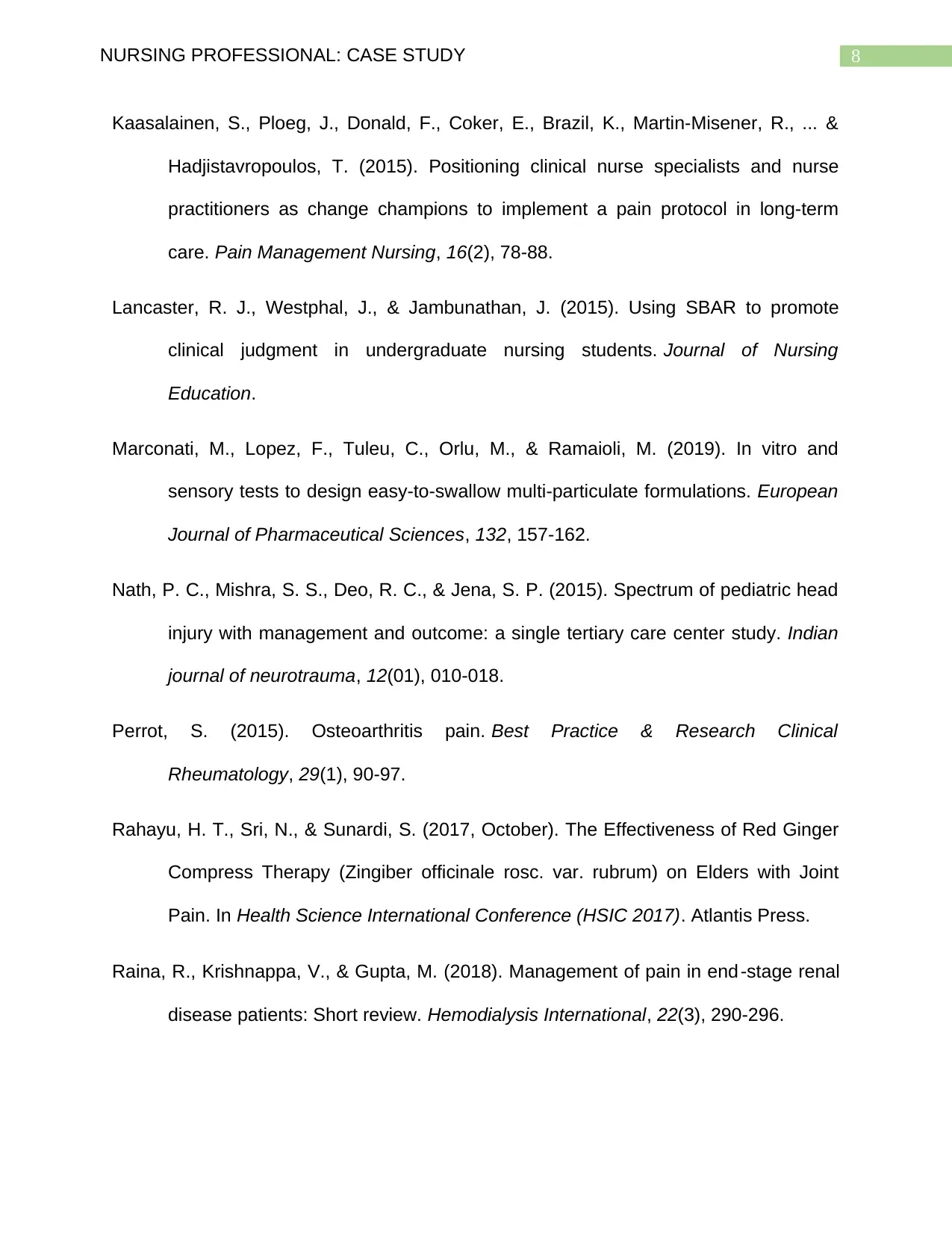
8NURSING PROFESSIONAL: CASE STUDY
Kaasalainen, S., Ploeg, J., Donald, F., Coker, E., Brazil, K., Martin-Misener, R., ... &
Hadjistavropoulos, T. (2015). Positioning clinical nurse specialists and nurse
practitioners as change champions to implement a pain protocol in long-term
care. Pain Management Nursing, 16(2), 78-88.
Lancaster, R. J., Westphal, J., & Jambunathan, J. (2015). Using SBAR to promote
clinical judgment in undergraduate nursing students. Journal of Nursing
Education.
Marconati, M., Lopez, F., Tuleu, C., Orlu, M., & Ramaioli, M. (2019). In vitro and
sensory tests to design easy-to-swallow multi-particulate formulations. European
Journal of Pharmaceutical Sciences, 132, 157-162.
Nath, P. C., Mishra, S. S., Deo, R. C., & Jena, S. P. (2015). Spectrum of pediatric head
injury with management and outcome: a single tertiary care center study. Indian
journal of neurotrauma, 12(01), 010-018.
Perrot, S. (2015). Osteoarthritis pain. Best Practice & Research Clinical
Rheumatology, 29(1), 90-97.
Rahayu, H. T., Sri, N., & Sunardi, S. (2017, October). The Effectiveness of Red Ginger
Compress Therapy (Zingiber officinale rosc. var. rubrum) on Elders with Joint
Pain. In Health Science International Conference (HSIC 2017). Atlantis Press.
Raina, R., Krishnappa, V., & Gupta, M. (2018). Management of pain in end ‐stage renal
disease patients: Short review. Hemodialysis International, 22(3), 290-296.
Kaasalainen, S., Ploeg, J., Donald, F., Coker, E., Brazil, K., Martin-Misener, R., ... &
Hadjistavropoulos, T. (2015). Positioning clinical nurse specialists and nurse
practitioners as change champions to implement a pain protocol in long-term
care. Pain Management Nursing, 16(2), 78-88.
Lancaster, R. J., Westphal, J., & Jambunathan, J. (2015). Using SBAR to promote
clinical judgment in undergraduate nursing students. Journal of Nursing
Education.
Marconati, M., Lopez, F., Tuleu, C., Orlu, M., & Ramaioli, M. (2019). In vitro and
sensory tests to design easy-to-swallow multi-particulate formulations. European
Journal of Pharmaceutical Sciences, 132, 157-162.
Nath, P. C., Mishra, S. S., Deo, R. C., & Jena, S. P. (2015). Spectrum of pediatric head
injury with management and outcome: a single tertiary care center study. Indian
journal of neurotrauma, 12(01), 010-018.
Perrot, S. (2015). Osteoarthritis pain. Best Practice & Research Clinical
Rheumatology, 29(1), 90-97.
Rahayu, H. T., Sri, N., & Sunardi, S. (2017, October). The Effectiveness of Red Ginger
Compress Therapy (Zingiber officinale rosc. var. rubrum) on Elders with Joint
Pain. In Health Science International Conference (HSIC 2017). Atlantis Press.
Raina, R., Krishnappa, V., & Gupta, M. (2018). Management of pain in end ‐stage renal
disease patients: Short review. Hemodialysis International, 22(3), 290-296.
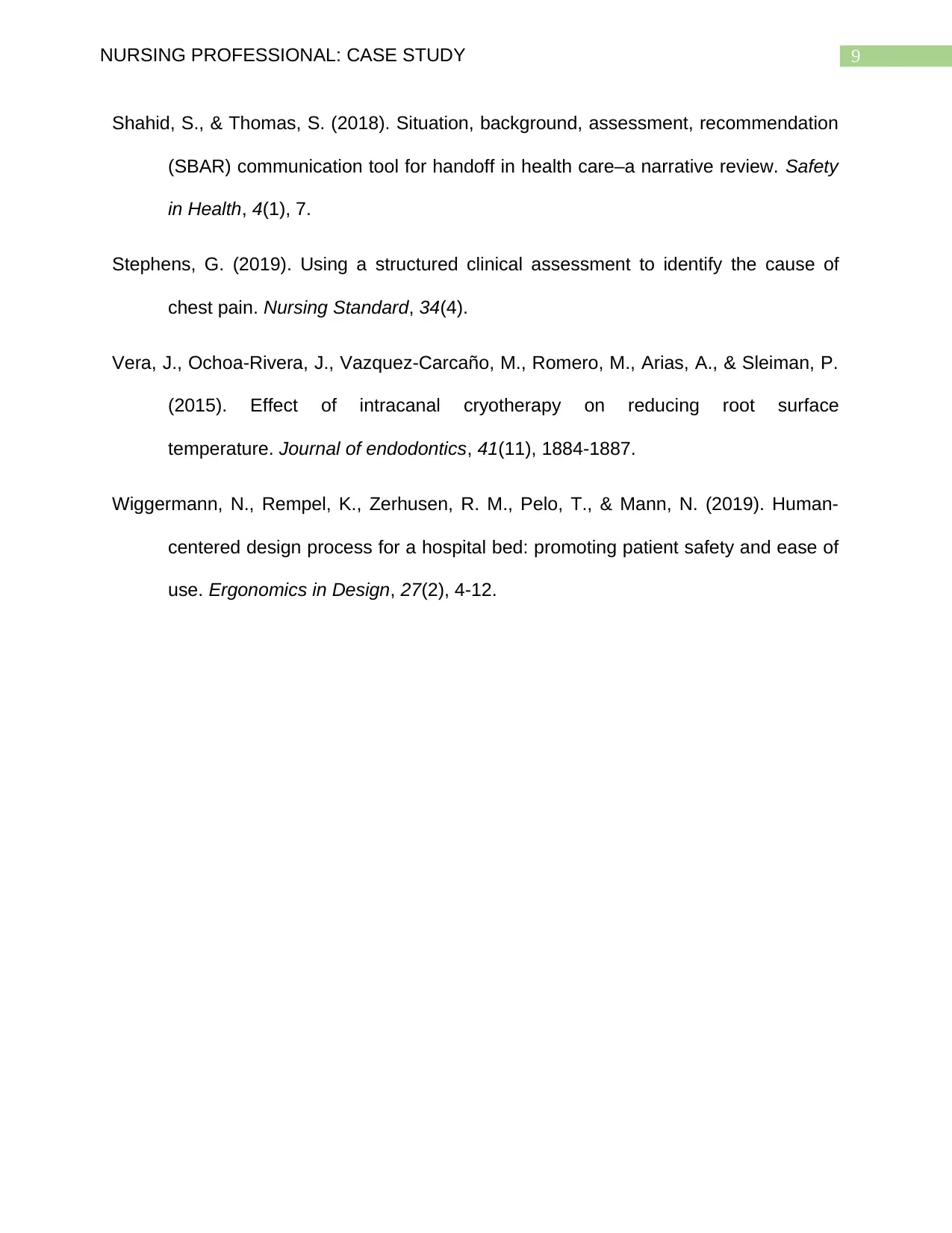
9NURSING PROFESSIONAL: CASE STUDY
Shahid, S., & Thomas, S. (2018). Situation, background, assessment, recommendation
(SBAR) communication tool for handoff in health care–a narrative review. Safety
in Health, 4(1), 7.
Stephens, G. (2019). Using a structured clinical assessment to identify the cause of
chest pain. Nursing Standard, 34(4).
Vera, J., Ochoa-Rivera, J., Vazquez-Carcaño, M., Romero, M., Arias, A., & Sleiman, P.
(2015). Effect of intracanal cryotherapy on reducing root surface
temperature. Journal of endodontics, 41(11), 1884-1887.
Wiggermann, N., Rempel, K., Zerhusen, R. M., Pelo, T., & Mann, N. (2019). Human-
centered design process for a hospital bed: promoting patient safety and ease of
use. Ergonomics in Design, 27(2), 4-12.
Shahid, S., & Thomas, S. (2018). Situation, background, assessment, recommendation
(SBAR) communication tool for handoff in health care–a narrative review. Safety
in Health, 4(1), 7.
Stephens, G. (2019). Using a structured clinical assessment to identify the cause of
chest pain. Nursing Standard, 34(4).
Vera, J., Ochoa-Rivera, J., Vazquez-Carcaño, M., Romero, M., Arias, A., & Sleiman, P.
(2015). Effect of intracanal cryotherapy on reducing root surface
temperature. Journal of endodontics, 41(11), 1884-1887.
Wiggermann, N., Rempel, K., Zerhusen, R. M., Pelo, T., & Mann, N. (2019). Human-
centered design process for a hospital bed: promoting patient safety and ease of
use. Ergonomics in Design, 27(2), 4-12.
1 out of 10
Related Documents
Your All-in-One AI-Powered Toolkit for Academic Success.
+13062052269
info@desklib.com
Available 24*7 on WhatsApp / Email
![[object Object]](/_next/static/media/star-bottom.7253800d.svg)
Unlock your academic potential
© 2024 | Zucol Services PVT LTD | All rights reserved.





